Peugeot 308 2016 Owner's Manual
Manufacturer: PEUGEOT, Model Year: 2016, Model line: 308, Model: Peugeot 308 2016Pages: 398, PDF Size: 9.38 MB
Page 141 of 398
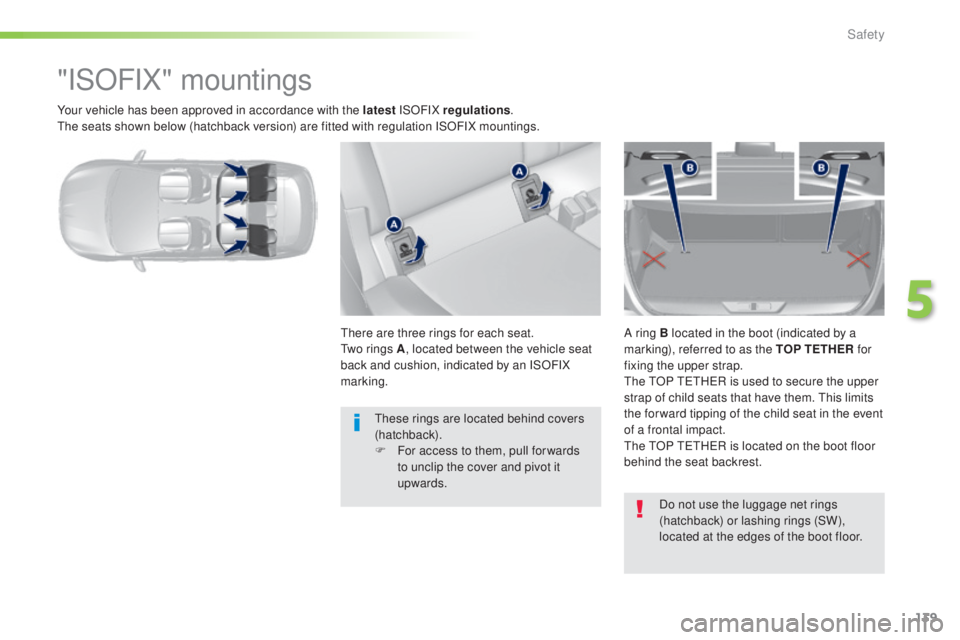
139
308_en_Chap05_securite_ed02-2015
Your vehicle has been approved in accordance with the latest ISOFIX regulations.the s
eats shown below (hatchback version) are fitted with regulation ISOFIX mountings.
"ISOFIX" mountings
there are three rings for each seat.two rings A , located between the vehicle seat
back and cushion, indicated by an ISOFIX
marking. A ring B located in the boot (indicated by a
marking), referred to as the TOP TETHER for
fixing the upper strap.
the tOP t
et
HeR is u
sed to secure the upper
strap of child seats that have them.
thi
s limits
the for ward tipping of the child seat in the event
of a frontal impact.
the tOP t
et
HeR is l
ocated on the boot floor
behind the seat backrest.
Do not use the luggage net rings
(hatchback) or lashing rings (SW),
located at the edges of the boot floor.
the
se rings are located behind covers
(hatchback).
F
Fo
r access to them, pull for wards
to unclip the cover and pivot it
upwards.
5
Safety
Page 142 of 398
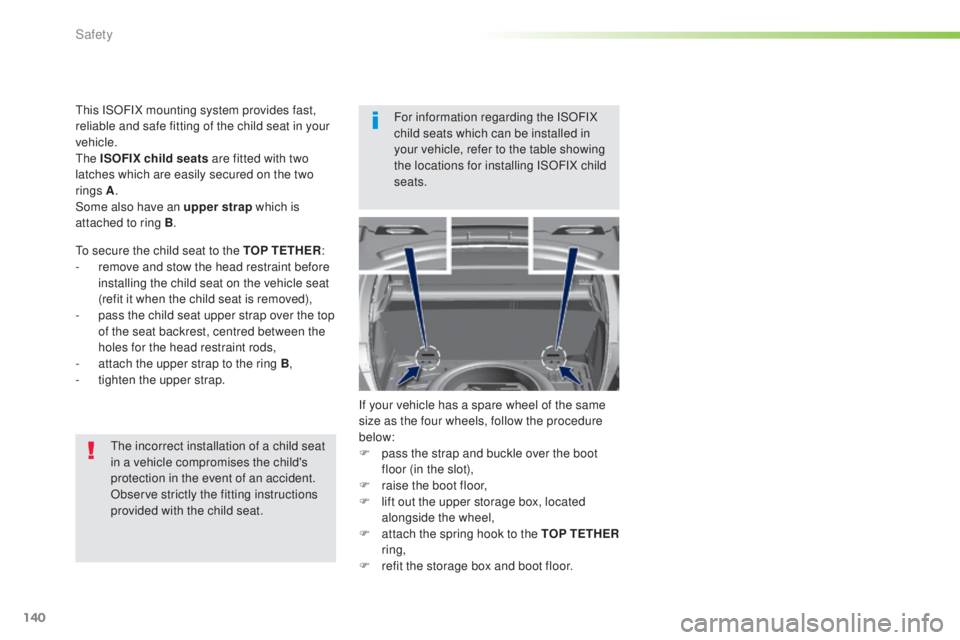
140
308_en_Chap05_securite_ed02-2015
the incorrect installation of a child seat
i n a vehicle compromises the child's
protection in the event of an accident.
Observe strictly the fitting instructions
provided with the child seat.
to se
cure the child seat to the TOP TETHER
:
-
re
move and stow the head restraint before
installing the child seat on the vehicle seat
(refit it when the child seat is removed),
-
pa
ss the child seat upper strap over the top
of the seat backrest, centred between the
holes for the head restraint rods,
-
at
tach the upper strap to the ring B,
-
ti
ghten the upper strap.
If your vehicle has a spare wheel of the same
size as the four wheels, follow the procedure
below:
F pa ss the strap and buckle over the boot
floor (in the slot),
F
ra
ise the boot floor,
F
li
ft out the upper storage box, located
alongside the wheel,
F
at
tach the spring hook to the TOP TETHER
ring,
F
re
fit the storage box and boot floor.
thi
s ISOFIX mounting system provides fast,
reliable and safe fitting of the child seat in your
vehicle.
the
ISOFIX child seats are fitted with two
latches which are easily secured on the two
rings A .
Some also have an upper strap which is
attached to ring B . For information regarding the ISOFIX
child seats which can be installed in
your vehicle, refer to the table showing
the locations for installing ISOFIX child
seats.
Safety
Page 143 of 398
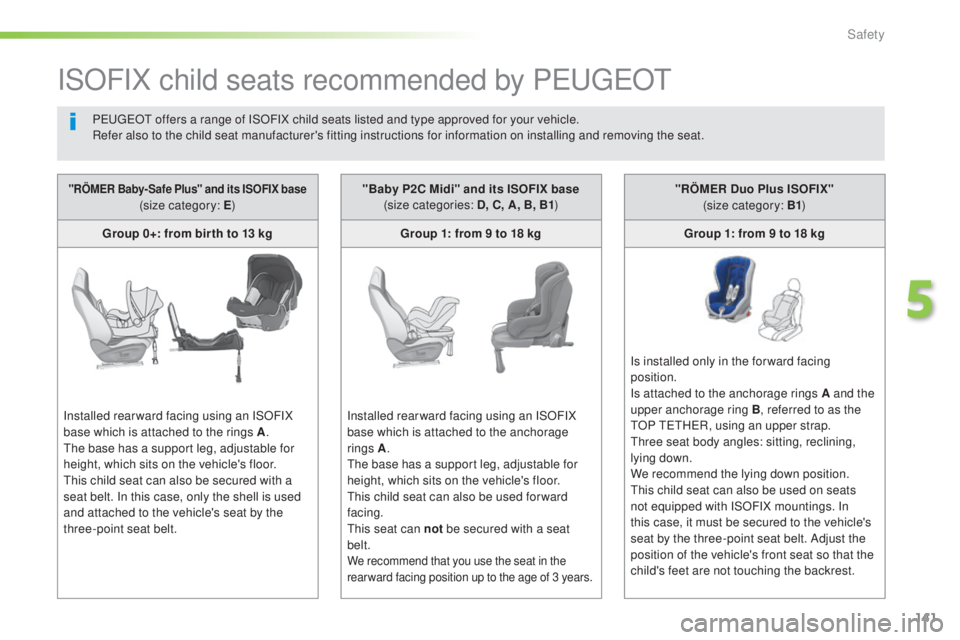
141
308_en_Chap05_securite_ed02-2015
ISOFIX child seats recommended by PeugeOt
PeugeOt offers a range of ISOFIX child seats listed and type approved for your vehicle.
Refer also to the child seat manufacturer's fitting instructions for information on installing and removing the seat.
"RÖMER Baby- Safe Plus" and its ISOFIX base (size category: E)
Group 0+: from bir th to 13 kg
Installed rearward facing using an ISOFIX
base which is attached to the rings A .
the b
ase has a support leg, adjustable for
height, which sits on the vehicle's floor.
thi
s child seat can also be secured with a
seat belt. In this case, only the shell is used
and attached to the vehicle's seat by the
three-point seat belt. "Baby P2C Midi" and its ISOFIX base
(size categories: D, C, A, B, B1 )
Group 1: from 9 to 18 kg
Installed rearward facing using an ISOFIX
base which is attached to the anchorage
rings A .
the b
ase has a support leg, adjustable for
height, which sits on the vehicle's floor.
thi
s child seat can also be used for ward
facing.
thi
s seat can not be secured with a seat
belt.
We recommend that you use the seat in the
rear ward facing position up to the age of 3 years.
"RÖMER Duo Plus ISOFIX" (size category: B1 )
Group 1: from 9 to 18 kg
Is installed only in the for ward facing
position.
Is attached to the anchorage rings A and the
upper anchorage ring B , referred to as the
tOP t
et
HeR, u
sing an upper strap.
thr
ee seat body angles: sitting, reclining,
lying down.
We recommend the lying down position.
thi
s child seat can also be used on seats
not equipped with ISOFIX mountings. In
this case, it must be secured to the vehicle's
seat by the three-point seat belt. Adjust the
position of the vehicle's front seat so that the
child's feet are not touching the backrest.
5
Safety
Page 144 of 398
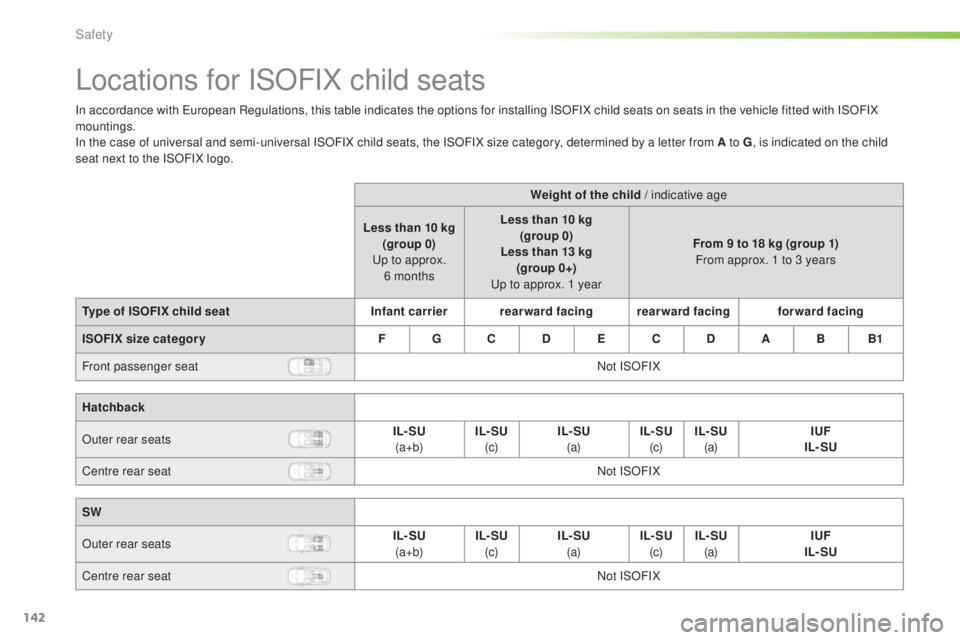
142
308_en_Chap05_securite_ed02-2015
Locations for ISOFIX child seats
In accordance with european Regulations, this table indicates the options for installing ISOFIX child seats on seats in the vehicle fitted with ISOFIX
mountings.
In the case of universal and semi-universal ISOFIX child seats, the ISOFIX size category, determined by a letter from A to G , is indicated on the child
seat next to the ISOFIX logo.
Weight of the child / indicative age
Less than 10 kg (group 0)
up
to approx.
6
m
onthsLess than 10 kg
(group 0)
Less than 13 kg (group 0+)
up to a
pprox. 1 yearFrom 9 to 18 kg (group 1)
From approx. 1 to 3 years
Type of ISOFIX child seat Infant carrierrearward facing rearward facing forward facing
ISOFIX size categor y F G C D E C D A B B1
Front passenger seat Not ISOFIX
Hatchback
Outer rear seats IL- SU
(a+b) IL- SU
(c) IL- SU
(a) IL- SU
(c) IL- SU
(a) IUF
IL- SU
Centre rear seat Not ISOFIX
SW
Outer rear seats IL- SU
(a+b) IL- SU
(c) IL- SU
(a) IL- SU
(c) IL- SU
(a) IUF
IL- SU
Centre rear seat Not ISOFIX
Safety
Page 145 of 398
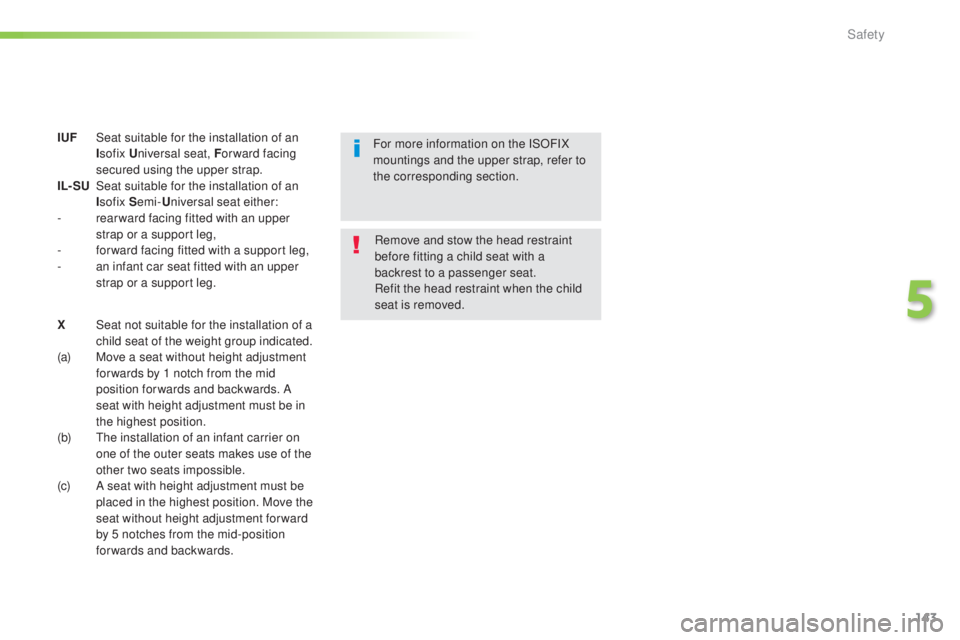
143
308_en_Chap05_securite_ed02-2015
IUF Seat suitable for the installation of an
Is
ofix Universal seat, F or ward facing
secured using the upper strap.
IL- SU
Se
at suitable for the installation of an
I sofix S emi-Universal seat either:
-
re
ar ward facing fitted with an upper
strap or a support leg,
-
fo
r ward facing fitted with a support leg,
-
an i
nfant car seat fitted with an upper
strap or a support leg. For more information on the ISOFIX
mountings and the upper strap, refer to
the corresponding section.
X
Se
at not suitable for the installation of a
child seat of the weight group indicated.
(a)
Mov
e a seat without height adjustment
for wards by 1 notch from the mid
position for wards and backwards. A
seat with height adjustment must be in
the highest position.
(b)
t
he i
nstallation of an infant carrier on
one of the outer seats makes use of the
other two seats impossible.
(c)
A se
at with height adjustment must be
placed in the highest position. Move the
seat without height adjustment forward
by 5 notches from the mid-position
forwards and backwards. Remove and stow the head restraint
before fitting a child seat with a
backrest to a passenger seat.
Refit the head restraint when the child
seat is removed.
5
Safety
Page 146 of 398
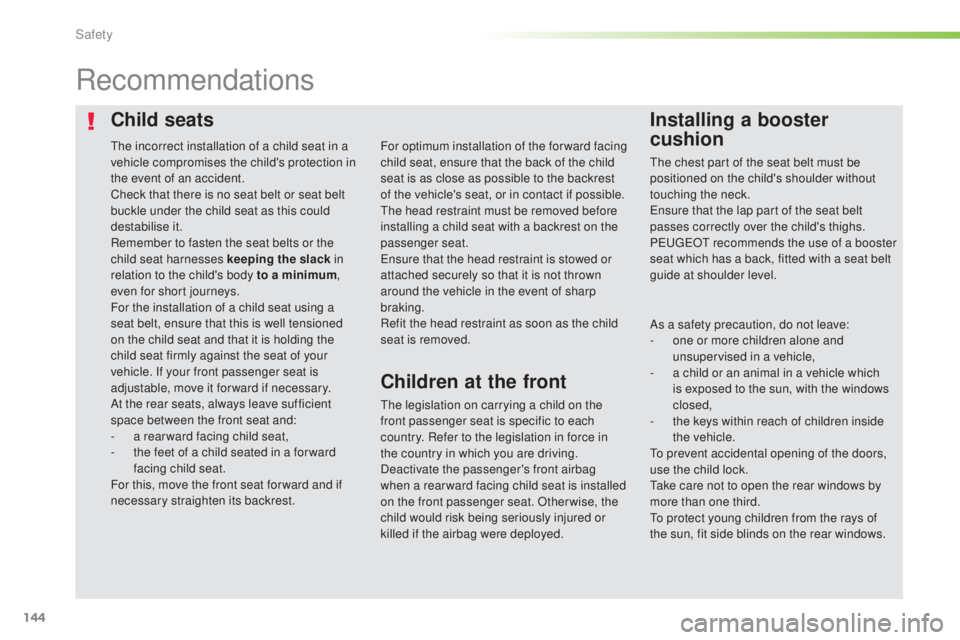
144
308_en_Chap05_securite_ed02-2015
Child seatsInstalling a booster
cushion
Recommendations
the legislation on carrying a child on the
f ront passenger seat is specific to each
country. Refer to the legislation in force in
the country in which you are driving.
Deactivate the passenger's front airbag
when a rear ward facing child seat is installed
on the front passenger seat. Otherwise, the
child would risk being seriously injured or
killed if the airbag were deployed. For optimum installation of the forward facing
child seat, ensure that the back of the child
seat is as close as possible to the backrest
of the vehicle's seat, or in contact if possible.
the h
ead restraint must be removed before
installing a child seat with a backrest on the
passenger seat.
ens
ure that the head restraint is stowed or
attached securely so that it is not thrown
around the vehicle in the event of sharp
braking.
Refit the head restraint as soon as the child
seat is removed.
the i
ncorrect installation of a child seat in a
vehicle compromises the child's protection in
the event of an accident.
Check that there is no seat belt or seat belt
buckle under the child seat as this could
destabilise it.
Remember to fasten the seat belts or the
child seat harnesses keeping the slack in
relation to the child's body to a minimum ,
even for short journeys.
For the installation of a child seat using a
seat belt, ensure that this is well tensioned
on the child seat and that it is holding the
child seat firmly against the seat of your
vehicle. If your front passenger seat is
adjustable, move it forward if necessary.
At the rear seats, always leave sufficient
space between the front seat and:
-
a re
ar ward facing child seat,
-
th
e feet of a child seated in a for ward
facing child seat.
For this, move the front seat for ward and if
necessary straighten its backrest.
Children at the front
the chest part of the seat belt must be
p ositioned on the child's shoulder without
touching the neck.
ens
ure that the lap part of the seat belt
passes correctly over the child's thighs.
P
eu
ge
Ot r
ecommends the use of a booster
seat which has a back, fitted with a seat belt
guide at shoulder level.
As a safety precaution, do not leave:
-
on
e or more children alone and
unsupervised in a vehicle,
-
a ch
ild or an animal in a vehicle which
is exposed to the sun, with the windows
closed,
-
th
e keys within reach of children inside
the vehicle.
to pr
event accidental opening of the doors,
use the child lock.
tak
e care not to open the rear windows by
more than one third.
to pr
otect young children from the rays of
the sun, fit side blinds on the rear windows.
Safety
Page 147 of 398
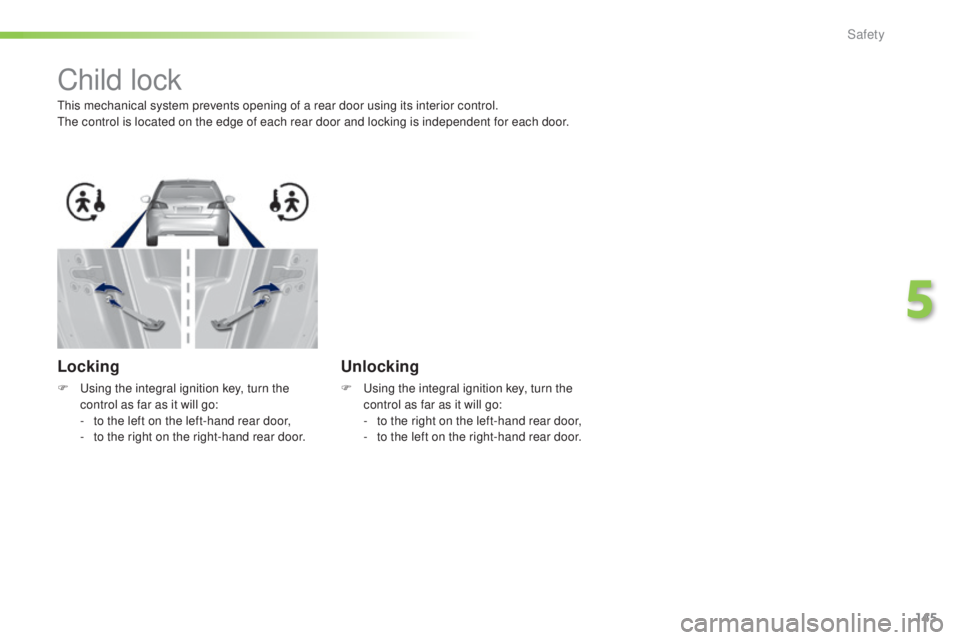
145
308_en_Chap05_securite_ed02-2015
Child lock
this mechanical system prevents opening of a rear door using its interior control.the control is located on the edge of each rear door and locking is independent for each door.
Locking
F using the integral ignition key, turn the
c ontrol as far as it will go:
-
to t
he left on the left-hand rear door,
-
to t
he right on the right-hand rear door.
Unlocking
F using the integral ignition key, turn the
c ontrol as far as it will go:
-
to t
he right on the left-hand rear door,
-
to t
he left on the right-hand rear door.
5
Safety
Page 148 of 398
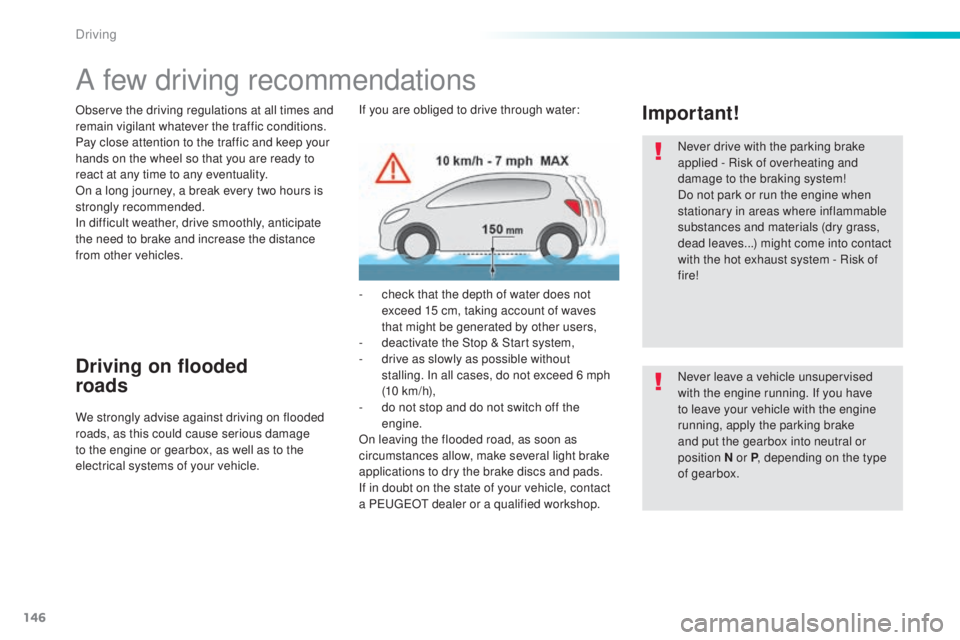
146
308_en_Chap06_conduite_ed02-2015
A few driving recommendations
Observe the driving regulations at all times and
remain vigilant whatever the traffic conditions.
Pay close attention to the traffic and keep your
hands on the wheel so that you are ready to
react at any time to any eventuality.
On a long journey, a break every two hours is
strongly recommended.
In difficult weather, drive smoothly, anticipate
the need to brake and increase the distance
from other vehicles.Never drive with the parking brake
applied - Risk of overheating and
damage to the braking system!
Do not park or run the engine when
stationary in areas where inflammable
substances and materials (dry grass,
dead leaves...) might come into contact
with the hot exhaust system - Risk of
fire!
Never leave a vehicle unsupervised
with the engine running. If you have
to leave your vehicle with the engine
running, apply the parking brake
and put the gearbox into neutral or
position
N
or P, depending on the type
of gearbox.
Driving on flooded
roads
We strongly advise against driving on flooded
roads, as this could cause serious damage
to the engine or gearbox, as well as to the
electrical systems of your vehicle.
Important!If you are obliged to drive through water:
-
ch
eck that the depth of water does not
exceed 15 cm, taking account of waves
that might be generated by other users,
-
de
activate the Stop & Start system,
-
dr
ive as slowly as possible without
stalling. In all cases, do not exceed 6 mph
(10
k
m/h),
-
do n
ot stop and do not switch off the
engine.
On leaving the flooded road, as soon as
circumstances allow, make several light brake
applications to dry the brake discs and pads.
If in doubt on the state of your vehicle, contact
a P
eu
ge
Ot d
ealer or a qualified workshop.
Driving
Page 149 of 398
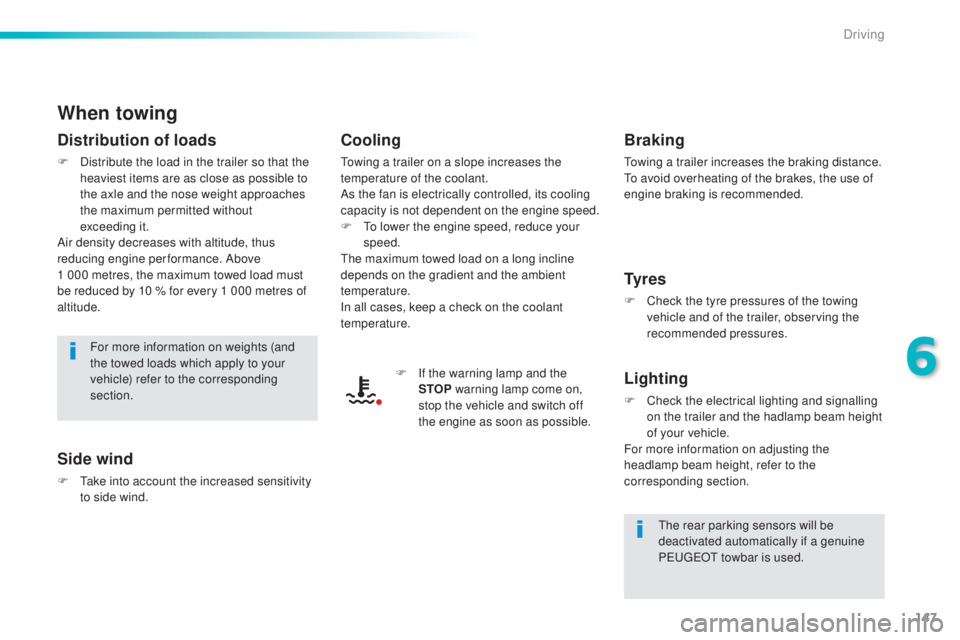
147
308_en_Chap06_conduite_ed02-2015
When towing
Distribution of loads
F Distribute the load in the trailer so that the
heaviest items are as close as possible to
the axle and the nose weight approaches
the maximum permitted without
exceeding
it
.
Air density decreases with altitude, thus
reducing engine performance. Above
1
0
00
m
etres, the maximum towed load must
be reduced by 10
% f
or every 1
0
00 metres of
altitude.
Side wind
F take into account the increased sensitivity
t o side wind.
Cooling
towing a trailer on a slope increases the
t emperature of the coolant.
As the fan is electrically controlled, its cooling
capacity is not dependent on the engine speed.
F
t
o lo
wer the engine speed, reduce your
speed.
the m
aximum towed load on a long incline
depends on the gradient and the ambient
temperature.
In all cases, keep a check on the coolant
temperature.
F
If t
he warning lamp and the
STOP warning lamp come on,
stop the vehicle and switch off
the engine as soon as possible.
Braking
towing a trailer increases the braking distance.to av oid overheating of the brakes, the use of
engine braking is recommended.
Ty r e s
F Check the tyre pressures of the towing
v ehicle and of the trailer, observing the
recommended pressures.
Lighting
F Check the electrical lighting and signalling
o n the trailer and the hadlamp beam height
of your vehicle.
For more information on adjusting the
headlamp beam height, refer to the
corresponding section.
For more information on weights (and
the towed loads which apply to your
vehicle) refer to the corresponding
section.
the r
ear parking sensors will be
deactivated automatically if a genuine
P
eu
ge
Ot t
owbar is used.
6
Driving
Page 150 of 398
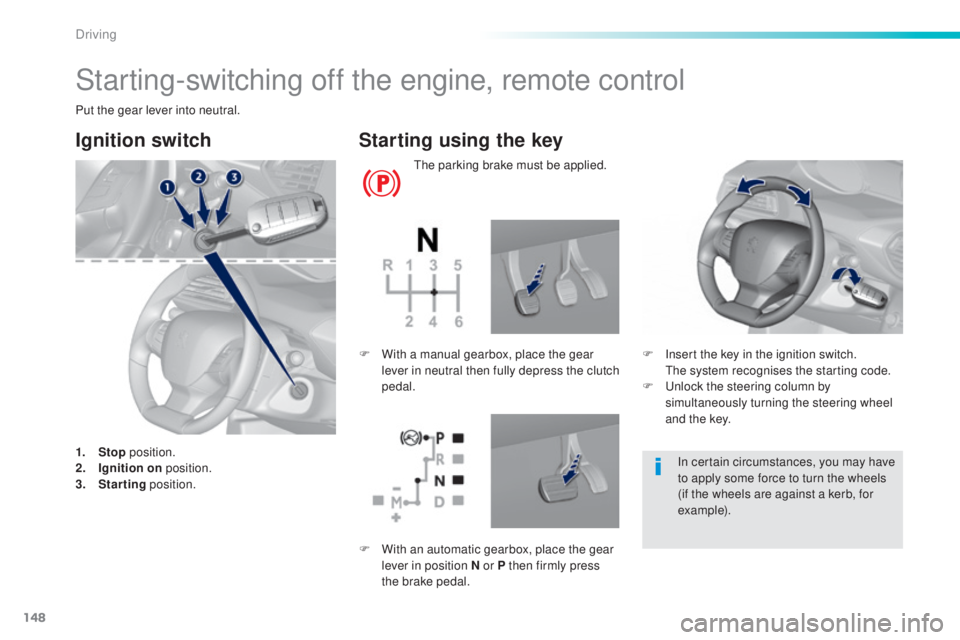
148
308_en_Chap06_conduite_ed02-2015
Starting-switching off the engine, remote control
Put the gear lever into neutral.
Ignition switch
1. Stop p osition.
2. Ig nition on position.
3.
Sta
rting position.
Starting using the key
the parking brake must be applied.
F
In
sert the key in the ignition switch.
the s
ystem recognises the starting code.
F
u
nl
ock the steering column by
simultaneously turning the steering wheel
and the key.
F
Wi
th a manual gearbox, place the gear
lever in neutral then fully depress the clutch
pedal.
In certain circumstances, you may have
to apply some force to turn the wheels
(if the wheels are against a kerb, for
example).
F
Wi
th an automatic gearbox, place the gear
lever in position N or P then firmly press
the brake pedal.
Driving